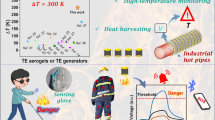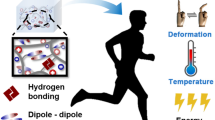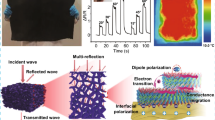Abstract
Ionogels have enabled flexible electronic devices for wide-ranging innovative applications in wearable electronics, soft robotics, and intelligent systems. Ionogels for flexible electronics need to essentially tolerate stress, temperature, humidity, and solvents that may cause their electrical conductivity, structural stability, processing compatibility and sensibility failure. Herein, we developed a novel in-situ photopolymerization protocol to fabricate intrinsically conductive, self-gated ionogels via ion-restriction dual effects. Highly sensitive and intelligent safety sensors with tunable stretchability, robust chemical stability, favorable printability, and complete recyclability, are programmed from defined microneedle arrays printed by the intrinsically conductive ionogel. Ultrahigh elasticity (~ 794% elongation), high compression tolerance (~ 90% deformation), improved mechanical strength (tensile and compressive strength of ~ 2.0 MPa and ~ 16.3 MPa, respectively) and remarkable transparency (> 91.1% transmittance), as well as high-temperature sensitivity (− 2.07% °C−1) and a wide working range (− 40 to 200 °C) can be achieved. In particular, the intrinsic sensing mechanisms of ion-restriction dual effects are unlocked based on DFT calculations and MD simulations, and operando temperature-dependent FTIR, and Raman technologies. Moreover, the real-time intelligent monitoring systems toward physical signals and precise temperature based on the microneedle array-structures sensors are also presented and demonstrate great potential applications for extreme environments, e.g., fire, deep-sea or aerospace.
Graphical Abstract








Similar content being viewed by others
Data Availability
All data supporting the findings of this study are available within this article and Supplementary Information or from the corresponding author upon reasonable request. Source data are provided with this paper.
References
Liu H, et al. Ionogel infiltrated paper as flexible electrode for wearable all-paper based sensors in active and passive modes. Nano Energy. 2019;66: 104161.
Zhao G, et al. Transparent and stretchable triboelectric nanogenerator for self-powered tactile sensing. Nano Energy. 2019;59:302–10.
Qu X, Xue J, Liu Y, Rao W, Liu Z, Li Z. Fingerprint-shaped triboelectric tactile sensor. Nano Energy. 2022;98:107324.
Liu D, et al. Conductive polymer based hydrogels and their application in wearable sensors: a review. Mater Horiz. 2023;10:2800–23.
Fu Q, Chen Y, Sorieul M. Wood-Based Flexible Electronics. ACS Nano. 2020;14:3528–38.
Zhou B, et al. Mechanoluminescent-Triboelectric Bimodal Sensors for Self-Powered Sensing and Intelligent Control. Nanomicro Lett. 2023;15:72.
Hu D, Giorgio-Serchi F, Zhang S, Yang Y. Stretchable e-skin and transformer enable high-resolution morphological reconstruction for soft robots. Nat Mach Intell. 2023;5(3):261–72.
Tee BC, Wang C, Allen R, Bao Z. An electrically and mechanically self-healing composite with pressure- and flexion-sensitive properties for electronic skin applications. Nat Nanotechnol. 2012;7:825–32.
Chortos A, Liu J, Bao Z. Pursuing prosthetic electronic skin. Nat Mater. 2016;15:937–50.
Yoo S, et al. Responsive materials and mechanisms as thermal safety systems for skin-interfaced electronic devices. Nat Commun. 2023;14:1024.
Chortos A, Bao Z. Skin-inspired electronic devices. Mater Today. 2014;17:321–31.
Wang S, Oh JY, Xu J, Tran H, Bao Z. Skin-Inspired Electronics: An Emerging Paradigm. Acc Chem Res. 2018;51:1033–45.
Tian Q, et al. Hairy-Skin-Adaptive Viscoelastic Dry Electrodes for Long-Term Electrophysiological Monitoring. Adv Mater. 2023;35:e2211236.
Wang Z, et al. A universal interfacial strategy enabling ultra‐robust gel hybrids for extreme epidermal bio‐monitoring. Adv Funct Mater. 2023;33:2301117.
Jayachandran D, et al. A low-power biomimetic collision detector based on an in-memory molybdenum disulfide photodetector. Nat Electron. 2020;3:646–55.
Kang SK, et al. Bioresorbable silicon electronic sensors for the brain. Nature. 2016;530:71–6.
Lee GH, et al. Multifunctional materials for implantable and wearable photonic healthcare devices. Nat Rev Mater. 2020;5:149–65.
Son D, et al. Multifunctional wearable devices for diagnosis and therapy of movement disorders. Nat Nanotechnol. 2014;9:397–404.
Hao S, Fu Q, Meng L, Xu F, Yang J. A biomimetic laminated strategy enabled strain-interference free and durable flexible thermistor electronics. Nat Commun. 2022;13:6472.
Lu Y, et al. Multimodal Plant Healthcare Flexible Sensor System. ACS Nano. 2020;14:10966–75.
Bakadia BM, et al. Biodegradable and injectable poly(vinyl alcohol) microspheres in silk sericin-based hydrogel for the controlled release of antimicrobials: application to deep full-thickness burn wound healing. Adv Compos Hybrid Mater. 2022;5:2847–72.
Vaghasiya JV, Mayorga-Martinez CC, Vyskocil J, Pumera M. Black phosphorous-based human-machine communication interface. Nat Commun. 2023;14:2.
Sun Z, Zhu M, Shan X, Lee C. Augmented tactile-perception and haptic-feedback rings as human-machine interfaces aiming for immersive interactions. Nat Commun. 2022;13:5224.
Zarei M, Lee G, Lee SG, Cho K. Advances in Biodegradable Electronic Skin: Material Progress and Recent Applications in Sensing, Robotics, and Human-Machine Interfaces. Adv Mater. 2022;35:2203193.
Zhang H, et al. Stretchable and Ultrasensitive Intelligent Sensors for Wireless Human-Machine Manipulation. Adv Funct Mater. 2021;31:2009466.
Liu H, et al. Approaching intrinsic dynamics of MXenes hybrid hydrogel for 3D printed multimodal intelligent devices with ultrahigh superelasticity and temperature sensitivity. Nat Commun. 2022;13:3420.
Cao CF, et al. Fire Intumescent, High-Temperature Resistant, Mechanically Flexible Graphene Oxide Network for Exceptional Fire Shielding and Ultra-Fast Fire Warning. Nanomicro Lett. 2022;14:92.
Cao L, et al. Electro-Blown Spun Silk/Graphene Nanoionotronic Skin for Multifunctional Fire Protection and Alarm. Adv Mater. 2021;33:2102500.
Li G, et al. Three-dimensional flexible electronics using solidified liquid metal with regulated plasticity. Nat Electron. 2023;6:154–63.
Chen B, et al. Liquid metal-tailored gluten network for protein-based e-skin. Nat Commun. 2022;13:1206.
Han S, Kim K, Lee SY, Moon S, Lee JY. Stretchable Electrodes Based on Over-Layered Liquid Metal Networks. Adv Mater. 2023;35:2210112.
Chen S, et al. Ultrahigh Strain-Insensitive Integrated Hybrid Electronics Using Highly Stretchable Bilayer Liquid Metal Based Conductor. Adv Mater. 2023;35:2208569.
Yang R, et al. 2D Transition Metal Dichalcogenides for Photocatalysis. Angew Chem Int Ed. 2023;62: e202218016.
Cao W, et al. Bioinspired MXene-Based User-Interactive Electronic Skin for Digital and Visual Dual-Channel Sensing. Nanomicro Lett. 2022;14:119.
Wang L, et al. Flexible multiresponse-actuated nacre-like MXene nanocomposite for wearable human-machine interfacing. Matter. 2022;5:3417–31.
Feng J, et al. Multifunctional MXene-Bonded Transport Network Embedded in Polymer Electrolyte Enables High-Rate and Stable Solid-State Zinc Metal Batteries. Adv Funct Mater. 2022;32:2207909.
Liao H, Guo X, Wan P, Yu G. Conductive MXene Nanocomposite Organohydrogel for Flexible, Healable, Low-Temperature Tolerant Strain Sensors. Adv Funct Mater. 2019;29:1904507.
Kong D, et al. Highly sensitive strain sensors with wide operation range from strong MXene-composited polyvinyl alcohol/sodium carboxymethylcellulose double network hydrogel. Adv Compos Hybrid Mater. 2022;5:1976–87.
Guo Y, Wei X, Gao S, Yue W, Li Y, Shen G. Recent Advances in Carbon Material-Based Multifunctional Sensors and Their Applications in Electronic Skin Systems. Adv Funct Mater. 2021;31:2104288.
Cai Y, et al. Extraordinarily Stretchable All-Carbon Collaborative Nanoarchitectures for Epidermal Sensors. Adv Mater. 2017;29:1606411.
Ye Y, Zhang Y, Chen Y, Han X, Jiang F. Cellulose Nanofibrils Enhanced, Strong, Stretchable, Freezing-Tolerant Ionic Conductive Organohydrogel for Multi-Functional Sensors. Adv Funct Mater. 2020;30:2003430.
Pang Y, et al. Epidermis Microstructure Inspired Graphene Pressure Sensor with Random Distributed Spinosum for High Sensitivity and Large Linearity. ACS Nano. 2018;12:2346–54.
Li Y, et al. Ultrasensitive Pressure Sensor Sponge Using Liquid Metal Modulated Nitrogen-Doped Graphene Nanosheets. Nano Lett. 2022;22:2817–25.
Yang R, et al. Synthesis of atomically thin sheets by the intercalation-based exfoliation of layered materials. Nature Synthesis. 2023;2:101–18.
Ebrahim S, Shokry A, Khalil MMA, Ibrahim H, Soliman M. Polyaniline/Ag nanoparticles/graphene oxide nanocomposite fluorescent sensor for recognition of chromium (VI) ions. Sci Rep. 2020;10:13617.
Fang B, et al. Scalable production of ultrafine polyaniline fibres for tactile organic electrochemical transistors. Nat Commun. 2022;13:2101.
Xue M, Li F, Chen D, Yang Z, Wang X, Ji J. Gas Sensors: High-Oriented Polypyrrole Nanotubes for Next-Generation Gas Sensor Adv. Mater. 2016;28:8067–8067.
Park H, et al. Microporous Polypyrrole-Coated Graphene Foam for High-Performance Multifunctional Sensors and Flexible Supercapacitors. Adv Funct Mater. 2018;28:1707013.
Qin J, et al. Hierarchical Ordered Dual-Mesoporous Polypyrrole/Graphene Nanosheets as Bi-Functional Active Materials for High-Performance Planar Integrated System of Micro-Supercapacitor and Gas Sensor. Adv Funct Mater. 2020;30:1909756.
Pan L, et al. An ultra-sensitive resistive pressure sensor based on hollow-sphere microstructure induced elasticity in conducting polymer film. Nat Commun. 2014;5:3002.
Yuk H, Lu B, Zhao X. Hydrogel bioelectronics. Chem Soc Rev. 2019;48:1642–67.
Cheng S, et al. Ultrathin Hydrogel Films Toward Breathable Skin-Integrated Electronics. Adv Mater. 2022;35:2206793.
Liu X, Inda ME, Lai Y, Lu TK, Zhao X. Engineered Living Hydrogels. Adv Mater. 2022;34:2201326.
Hu L, et al. Hydrogel-Based Flexible Electronics. Adv Mater. 2022;35:2205326.
Han IK, et al. Electroconductive, Adhesive, Non-swelling, and Viscoelastic Hydrogels for Bioelectronics. Adv Mater. 2022;35:2203431.
Cheng K, et al. Mechanically robust and conductive poly(acrylamide) nanocomposite hydrogel by the synergistic effect of vinyl hybrid silica nanoparticle and polypyrrole for human motion sensing. Adv Compos Hybrid Mater. 2022;5:2834–46.
Lei Z, Wu P. Short-term plasticity, multimodal memory, and logical responses mimicked in stretchable hydrogels. Matter. 2023;6:429–44.
Li X, Liu J, Zhang X. Pressure/temperature dual‐responsive cellulose nanocrystal hydrogels for on‐demand schemochrome patterning. Adv Funct Mater. 2023;33:2306208.
Yu Z, Wu P. Underwater Communication and Optical Camouflage Ionogels. Adv Mater. 2021;33:2008479.
Luo Z, Li W, Yan J, Sun J. Roles of Ionic Liquids in Adjusting Nature of Ionogels: A Mini Review. Adv Funct Mater. 2022;32:2203988.
Cao Y, et al. Self-healing electronic skins for aquatic environments. Nat Electron. 2019;2:75–82.
Lei Z, Wu P. A highly transparent and ultra-stretchable conductor with stable conductivity during large deformation. Nat Commun. 2019;10:3429.
Sun L, et al. Highly Transparent, Stretchable, and Self-Healable Ionogel for Multifunctional Sensors, Triboelectric Nanogenerator, and Wearable Fibrous Electronics. Adv Fiber Mater. 2021;4:98–107.
Wang J, et al. Intrinsic ionic confinement dynamic engineering of ionomers with low dielectric-k, high healing and stretchability for electronic device reconfiguration. Chem Eng J. 2023;453: 139837.
Zheng Y, Cui T, Wang J, Ge H, Gui Z. Unveiling innovative design of customizable adhesive flexible devices from self-healing ionogels with robust adhesion and sustainability. Chem Eng J. 2023;471: 144617.
Xu L, et al. A Transparent, Highly Stretchable, Solvent-Resistant, Recyclable Multifunctional Ionogel with Underwater Self-Healing and Adhesion for Reliable Strain Sensors. Adv Mater. 2021;33:2105306.
Li W, et al. Recyclable, Healable, and Tough Ionogels Insensitive to Crack Propagation. Adv Mater. 2022;34:2203049.
Wen D-L, et al. Silk Fibroin-Based Wearable All-Fiber Multifunctional Sensor for Smart Clothing. Adv Fiber Mater. 2022;4:873–84.
Lu T, Chen F. Multiwfn: a multifunctional wavefunction analyzer. J Comput Chem. 2012;33:580–92.
Lei Z, Wu P. Bioinspired Quasi-Solid Ionic Conductors: Materials, Processing, and Applications. Acc Mater Res. 2021;2:1203–14.
Liu H, et al. 3D Printed Flexible Strain Sensors: From Printing to Devices and Signals. Adv Mater. 2021;33:2004782.
Cui T, et al. Enhanced light trapping effect of hierarchical structure assembled from flower-like cobalt tetroxide and 3D-printed structure for efficient solar evaporation. Chem Eng J. 2023;451: 139102.
Acknowledgements
The research was financially supported by the National Key R&D Program of China (2020YFA0709900), the National Natural Science Foundation of China (22175167), and the National Key R&D Program of the MOST of China (Grant No. 2022YFA1602601).
Author information
Authors and Affiliations
Contributions
JZ and YZ conceived and designed this work. JZ and ZG provided financial support. YZ carried out the main experiments. YZ, JW, and TC performed the characterization and data analysis. YZ and JW performed molecular dynamics simulations and calculations. YZ and TC completed the finite-element simulation. HL and YZ performed the real-time intelligent monitoring systems design, construction, and operation. YZ and JZ wrote the manuscript. All authors discussed the results and revised the manuscript.
Corresponding authors
Ethics declarations
Conflict of Interest
The authors declare no conflicts of interest.
Additional information
Publisher's Note
Springer Nature remains neutral with regard to jurisdictional claims in published maps and institutional affiliations.
Supplementary Information
Below is the link to the electronic supplementary material.
Supplementary file1 (MP4 23042 KB)
Supplementary file2 (MP4 17803 KB)
Supplementary file3 (MP4 18552 KB)
Supplementary file4 (MP4 18401 KB)
Supplementary file5 (MP4 22783 KB)
Rights and permissions
Springer Nature or its licensor (e.g. a society or other partner) holds exclusive rights to this article under a publishing agreement with the author(s) or other rightsholder(s); author self-archiving of the accepted manuscript version of this article is solely governed by the terms of such publishing agreement and applicable law.
About this article
Cite this article
Zheng, Y., Liu, H., Wang, J. et al. Unlocking Intrinsic Conductive Dynamics of Ionogel Microneedle Arrays as Wearable Electronics for Intelligent Fire Safety. Adv. Fiber Mater. 6, 195–213 (2024). https://doi.org/10.1007/s42765-023-00344-x
Received:
Accepted:
Published:
Issue Date:
DOI: https://doi.org/10.1007/s42765-023-00344-x




